Scientific classification
Kingdom:
Phylum:
Chordata
Class:
Actinopterygii
Order:
Syngnathiformes
Family:
Aulostomidae
Genus:
Aulostomus
Species:
A. Strigosus
Binomial name (link Wikipedia)




Trumpet Fish
Poisson Trompette
Trompetenfisch
Pez Trompeta
Trompetvis
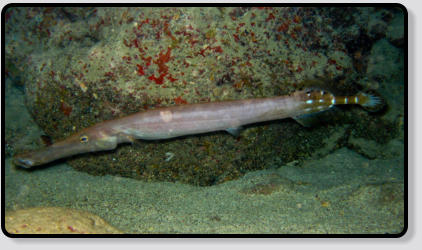
Description
Length: up to 1 metre.
Habitat: rocky bottom.
The Atlantic trumpetfish, Aulostomus strigosus (or incorrectly Atlantic coronetfish) is a species of trumpetfish in the family Aulostomidae. It is a
tropical marine fish found in shallow coastal waters in the eastern Atlantic Ocean from Mauritania to Namibia. Like other trumpetfish, they eat
mainly small fish and often shadow other piscivores while hunting. Aulostomus strigosus was found to be very closely related to the Aulostomus
maculatus, strongly supporting the theory that A. strigosus traversed the Atlantic to come to inhabit the Southeast Pacific.
Trumpetfish are long bodied fish with an upward facing mouth at the end of a long tubular snout.
It has the ability to change colour, either to communicate their excitrement or to camouflage them. The most frequent colours recorded are brown
or even blue, green or orange tones, or intermediate shades. It can display a pattern of pale, vertical and / or horizontal lines, or a dark mottling
on the body. The dorsal and anal fins are semitransparent with a black dot in fromt of it. Typically it has a pattern of four white spots on the body,
between the dorsal and anal fins; three white vertical lines in the long caudal peduncle and a black, submarginal, in each margin of the caudal fin
dot. It reaches a maximum length of 75cm.

Animalia
Scientific classification
Kingdom:
Phylum:
Chordata
Class:
Actinopterygii
Order:
Neopterygii
Family:
Teleostei
Genus:
Perciformes
Species:
S. Viridensis
Binomial name (link Wikipedia)




Barracuda
Barracuda
Barrakuda
Bicuda
Barracuda
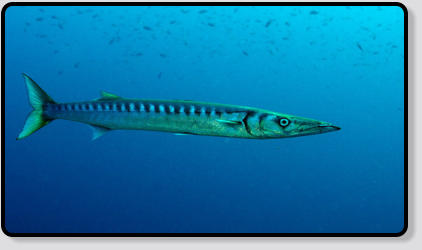
Description
Length: up to 150 cm.
Habitat: in mid waters close to platforms, reefs or any other feature that sticks up from the bottom.
The barracudas (Sphyraenidae) belong to the family of perciform fishes. The only genus of this family is Sphyraena.
This voracious robbers have fearsome teeth in the jaws, a slim, fijngeschubd, torpedo-shaped body and a sturdy, lobed tail built on propulsion.
In the Indo-Pacific region leads them mostly with hundreds at a time. These schools occur mainly along the seaward side of the walls of the coral
reef. Sphyraena sphyraena species also occurs in the Mediterranean Sea. On the Caribbean Reef life, however, they are often solitary.
In some parts of the world they are more feared than sharks, but usually such stories are greatly exaggerated. There are only few reliable
testimonies of accidents, fatal or not, as a result of an attack of barracudas.
No further information available on Wikipedia.
Animalia
Scientific classification
Kingdom:
Phylum:
Chordata
Class:
Actinopterygii
Order:
Beloniformes
Family:
Belonidae
Genus:
Platybelone
Species:
P. Argalus
Binomial name (link Wikipedia)




Needlefish
Poisson Flûte
Hornhecht
Agujas
Geep
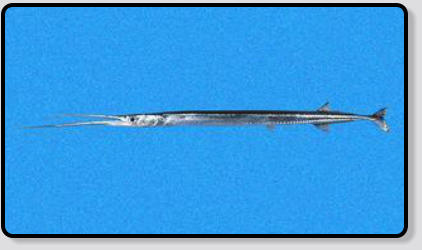
Description
Length: up to 1 metre.
Habitat: surface coastal waters.
The keeltail needlefish, sometimes called the keeled needlefish, is a tropical fish of the family Belonidae. It was described by the French
naturalist Charles Alexandre Lesueur in 1821.
Keeltail needlefish, like all needlefish, closely resemble North American freshwater gars (family Lepisosteidae). It is most recognized by the large,
flat keel-like structures running on either side of the tail.[1] They have 12 to 15 rays on their dorsal fins, and 17 to 20 rays on their anal fin.
Keeltail needlefish have gill-rakers, their caudal peduncles have lateral keels, with a lateral line running ventral to it, and grow up to 50 cm long
The keeltail needlefish's top jaw is also smaller than the lower one.
Keeltail needlefish are found in the western Atlantic ocean between North Carolina and Brazil, this includes the Gulf of Mexico, the Bahamas, and
the Caribbean sea.In the Indian ocean, they are known off of east Africa,with range continuing into the Pacific reaching the Hawaiian islands and
continuing north to the Ogasawara Islands
Animalia
Scientific classification
Kingdom:
Phylum:
Chordata
Class:
Actinopterygii
Order:
Syngnathiformes
Family:
Syngnathidae
Genus:
Syngnathus
Species:
S. Acus
Binomial name (link Wikipedia)




Pipefish
Sygnathe
Granadel
Pejepipas
Grote Zeenaald
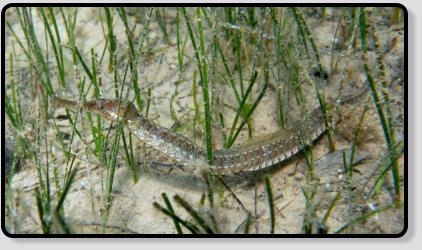
Length: up to 30 cm.
Habitat: bottom with seaweed and sea grass meadows.
The Greater pipefish, (Syngnathus acus, Linnaeus, 1758), is a pipefish of the family Syngnathidae. It is a seawater fish and the type specimen of
the genus Syngnathus.
The Greater pipefish has a long segmented armoured body, angular in cross section and stretching up 45 cm long with its stiff appearance. It
ranges a color brown to green in with broad alternating light and dark hue along it. Its customized by a long snout with mouth on end and a slight
hump on the top of the body just behind the eyes.
The fish is generally 33 cm to 35 cm in length with a reported maximum length of 47 cm. They are almost square in each segment of the body,
and known to feel rigid when handled. The Greater pipefish has distinctive body rings which are a sandy brown with darker bars covering his
body in between.
Description
Animalia
Scientific classification
Kingdom:
Phylum:
Chordata
Class:
Actinopterygii
Order:
Perciformes
Family:
Scombridae
Genus:
Acanthocybium
Species:
A. Solandri
Binomial name (link Wikipedia)




Wahoo
Bâtard
Thunfisch
Peto
Wahoo
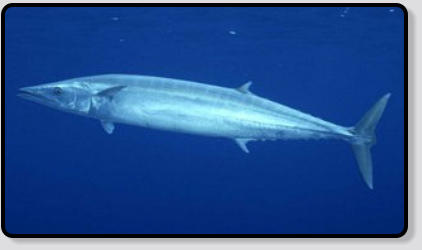
Length: up to 2 metres.
Habitat: coastal pelagic. Surface waters close to platforms and reefs.
Wahoo (Acanthocybium solandri) is a scombrid fish found worldwide in tropical and subtropical seas. It is best known to sports fishermen, as its
speed and high-quality flesh make it a prize game fish. In Hawaii, the wahoo is known as ono.[citation needed] Many Hispanic areas of the
Caribbean and Central America refer to this fish as peto.
Its body is elongated and covered with small, scarcely visible scales; the back is an iridescent blue, while the sides are silvery, with a pattern of
irregular vertical blue bars and have razor sharp teeth. These colors fade rapidly at death. The mouth is large, and both the upper and lower jaws
have a somewhat sharper appearance than those of king or Spanish mackerel.
Specimens have been recorded at up to 2.5 m (8 ft 2 in) in length, and weighing up to 83 kg (183 lb). Growth can be rapid. One specimen tagged
at 5 kg (11 lb) grew to 15 kg (33 lb) in one year. Wahoo can swim up to 60 mph (97 km/h).They are some of the fastest fish in the sea.
The wahoo may be distinguished from the related Atlantic king mackerel and from the Indo-Pacific narrow-barred Spanish mackerel by a fold of
skin which covers the mandible when its mouth is closed. In contrast, the mandible of the king mackerel is always visible as is also the case for
the smaller Spanish mackerel and Cero mackerel. The teeth of the wahoo are similar to those of king mackerel, but shorter and more closely set
together. The barracuda is sometimes confused with mackerel and wahoo, but is easy to distinguish from the latter two species. Barracuda have
prominent scales, larger, dagger-like teeth, and lack the caudal keels and blade-like (forked) tail characteristic of the scombrid (mackerel)
Description
Animalia
Scientific classification
Kingdom:
Phylum:
Chordata
Class:
Actinopterygii
Order:
Perciformes
Family:
Scombridae
Genus:
Sarda
Species:
S. Sarda
Binomial name (link Wikipedia)




Atlantic Bonito
Bonite
Bonito
Sierra
Bonito
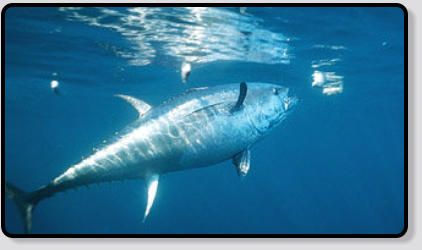
Length: up to 90 cm.
Habitat: coastal pelagic, close to platforms and reefs.
The Atlantic bonito, Sarda sarda, is a large mackerel-like fish of the family Scombridae. It is common in shallow waters of the Atlantic Ocean, the
Mediterranean Sea, and the Black Sea, where it is an important commercial and game fish.
Atlantic bonito belong to a group which have the dorsal fins very near, or separated by a narrow interspace. Its body is completely scaled, with
those scales in the pectoral fin area and the lateral line usually larger in size. Bonitos (fishes in the genus Sarda) differ from tuna by their
compressed bodies, their lack of teeth on the roof of the mouth, and certain differences in colouration.
Atlantic bonito share Atlantic waters with the striped bonito, Sarda orientalis (the Atlantic population of which is sometimes considered a separate
species, Sarda velox). The striped bonito has been taken on the Atlantic coast as far north as Cape Cod. It is similar in its habits, but somewhat
smaller than the more common Atlantic bonito. The Atlantic bonito can be distinguished from its relative by its dark oblique stripes on the back
and with a maxillary only about half as long as the head, whereas the striped bonito has striping on its topside nearly horizontal and a maxillary
more than half the length of the head.
Description
Animalia





Harry van Goor 2016
source: Wikipedia, the free encyclopedia


Categories: Long & Big Fisch
Scientific classification
Kingdom:
Phylum:
Chordata
Class:
Actinopterygii
Order:
Tetraodontiformes
Family:
Molidae
Genus:
Masturus
Species:
M. lanceolatus
Binomial name (link Wikipedia)




Ocean Sunfish
Poisson Lune
Rundschwanz-mondfisch
Peje Luna
Oceaan Maanvis
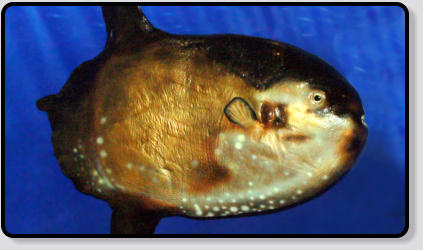
Length: up to 2 metres.
Habitat: pelagic.
Masturus lanceolatus also known as the sharptail mola is a species of mola found circumglobally in tropical and temperate waters. It is similar in
appearance to the ocean sunfish (Mola mola), but can be distinguished by the projection on its clavus (pseudo-tail). Other common names
include sharpfin sunfish, point-tailed sunfish, and trunkfish. Rarely encountered, very little is known of the biology or life history of the sharptail
mola. It has recently become important to commercial fisheries operating off eastern Taiwan. This species is the only member of its genus.
The distribution of the sharptail mola is worldwide in tropical and temperate waters.They are primarily inhabitants of the epipelagic zone, but are
rarely sighted at the surface, with many of those appearing to be ill and parasite-ridden. During the day, they spend most of their time at depths of
5–200 m (16–656 ft), preferring water temperatures above 20 °C, but making repeated dives into cooler, deeper water, possibly to feed or to
avoid predators. At night, they spend most of their time between 100 and 250 m (330 and 820 ft). They have been sighted in the mesopelagic
zone to a depth of 670 m (2,200 ft), but may descend to over 1,000 m (3,300 ft). One tagged individual in the Gulf of Mexico moved an average
of 10 km (6.2 mi) a day.
Description
Animalia







